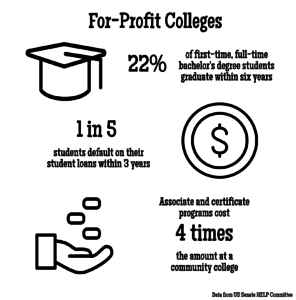You’ve seen the commercials. The soaring inspirational music over images of students of every age, gender and race achieving their dreams, their hard work paying off as they find success in the professional world. As the feel-good images fade, a logo flashes across the screen. DeVry. University of Phoenix. Capella University. ITT Tech.
Well, not ITT Tech anymore.

In September, the for-profit college giant ITT Tech, with more than 137 campuses nationwide, ceased operations after the U.S. Department of Education cut off the school from access to millions of dollars in the form of government loans and funds. The shutdown left some former students calling for a debt strike, petitioning the government to cancel student debt because of the school’s fraudulent behavior.
A school based on predatory recruiting and worthless degrees, seeking only to increase the money in its shareholders pockets, ITT Tech may seem like an extreme case, but in the world of for-profit colleges, it’s not close to an outlier.
Though it may seem like everyone at Redwood goes to an elite college, it’s not the case, as several students went to for-profit colleges this past year.
For-profit colleges, the schools run by a private corporations, promise opportunities to their students, but instead leave them with mountains of student debt and no job prospects.
The purpose of these schools isn’t to educate students, but to make money. As a study by Harvard Law states, “[For-profit colleges] are incentivized to maximize profits first by collecting tuition dollars from as many students as possible, without regard for the students’ academic preparation or ability to afford tuition, then by expending as little as possible on quality teachers and resources.”
According to a study by the U.S. Senate Committee on Health, Education, Labor, and Pensions (HELP), for-profit colleges devoted 22.4 percent of all revenues to marketing, advertising, recruiting and admissions staffing, 19.4 percent to profit and only 17.7 percent to student instruction.
Students at these colleges are shelling out money for an education that teaches them little. And a lot of them are doing so just to end up without a degree. Only a dismal 22 percent of first-time, full-time bachelor’s degree students graduate from for-profit colleges within six whole years, according to the Education Trust.
For-profit colleges disproportionately enroll students from lower socioeconomic backgrounds, according to a study by the Harvard Law School. However, these schools aren’t financially friendly. U.S. Senate HELP Committee data found that bachelor degree programs cost 19 percent more at for-profit schools than at public universities, and associate degree programs cost four times more than those at a community college.
Students at for-profit schools are encouraged to take out loans, with promises of a better future. A startling 96 percent of students at for-profit schools take out federal and/or private loans, but perhaps even more startling is the fact that more than one in five will default on those loans within only three years, according to Pew Research.
The debt that these students take on is much higher as well. The same study by Pew found that while only 5 percent of public university students and 14 percent of non-profit students take out $40,000 or more in student loans, a whole 25 percent of for-profit college students do. Simply put, students at for-profit schools are paying more, and are trapped with way more debt than their counterparts at other schools. And unfortunately, they aren’t even receiving a legitimate education.
These schools are successful in large part due to their predatory recruiting. Undercover tests of 15 different for-profit schools by the U.S. Government Accountability Office found that all 15 made deceptive statements and four even encouraged “fraudulent practices.”
In order to gain the most students (and rake in the most revenue), the schools deliberately deceive students on a number of fronts. According to the U.S. Senate HELP Committee, “For-profit colleges have also been using tactics that mislead prospective students with regard to the cost of the program, the time to complete the program, the completion rates of other students, the success of other students at finding jobs, the transferability of the credit, or the reputation and accreditation of the school.”
The promise of a college education for anyone that wants one is appealing, but for those seeking one through a for-profit institution, the reality is much more bleak. Students are much better off at community colleges and public universities than a for-profit. That way, they’ll graduate with actual, more manageable degrees and concrete career options.







